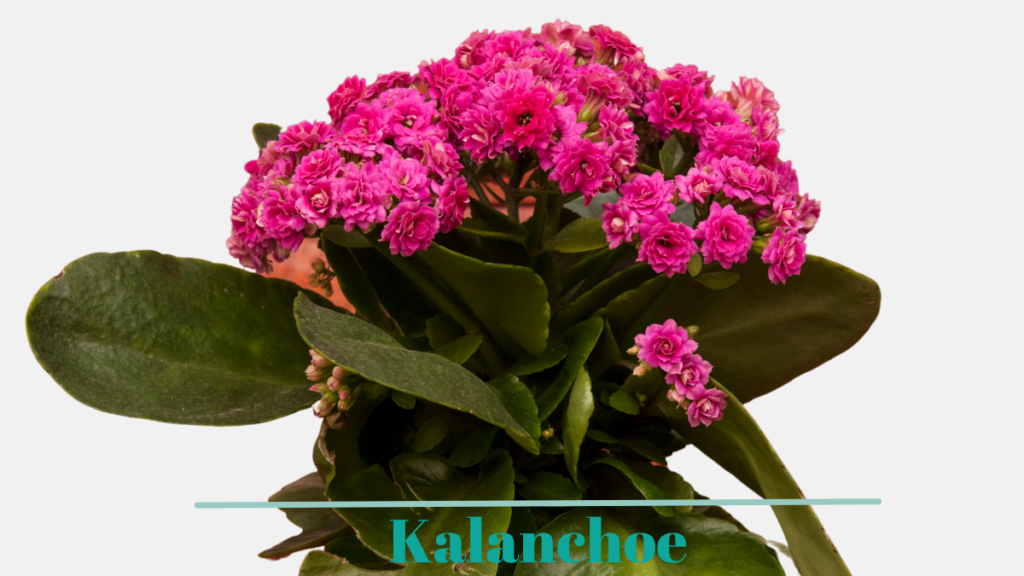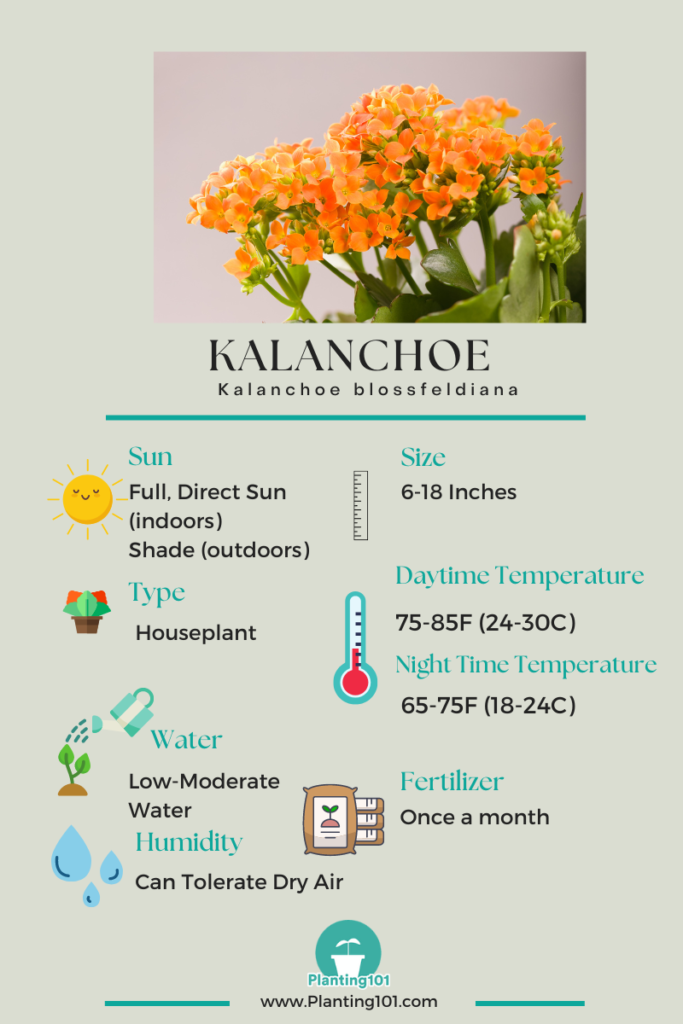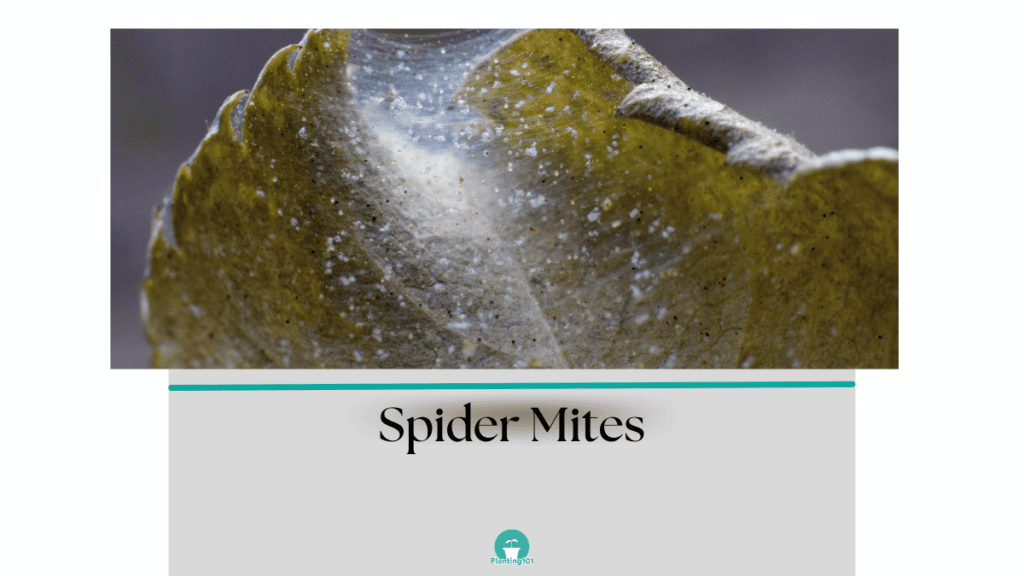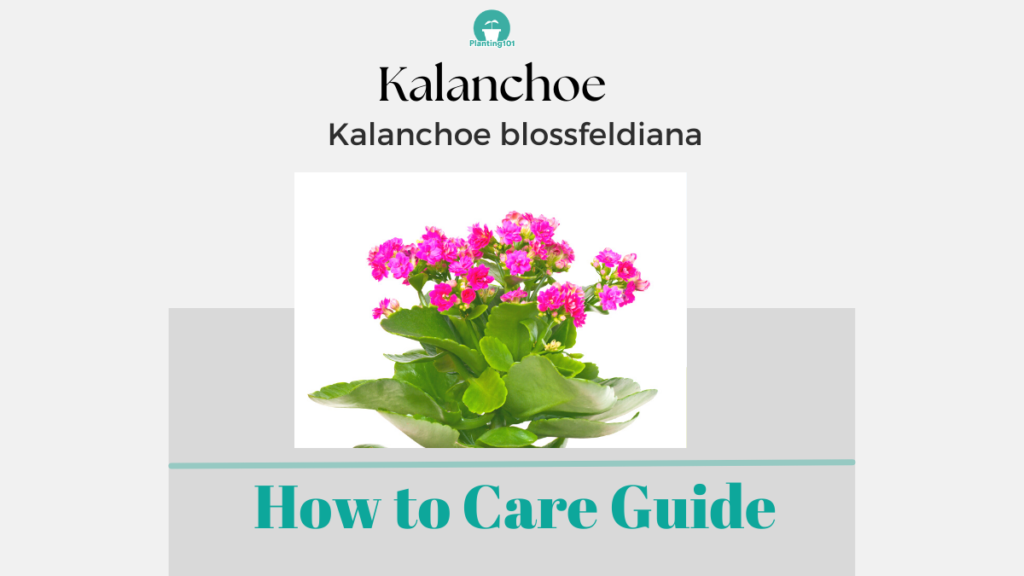Kalanchoe (Kalanchoe blossfeldiana) are flowering indoor plants popular in homes during the holiday season. If you are one of those people who throw away their Kalanchoe after the blooms die out, don’t! Kalanchoe plants are perennials and will flower for the next 3 years. It’s a short-day plant so it will need special treatment for it to bloom. However, the entire process to prepare your Kalanchoe to flower is very rewarding (albeit a little tricky). Keep your pets and children away from your Kalanchoe plant, it is toxic. Here is a beginner’s guide on how to care for your Kalanchoe plant.

Kalanchoe Infographic

Kalanchoe Basics
| Name | Kalanchoe |
| Scientific Name | Kalanchoe blossfeldiana |
| Care Level | Difficult |
| Light | Full, Direct Sun |
| Daytime Temperature | 75 to 85 F (24-30C) |
| Night Time Temperature | 65 to 75F (18-24C) |
| Water | Moderate Water |
| Humidity | Tolerates Regular Indoor Air |
| Potting | Well-draining, organic, all-purpose potting mix |
| Fertilizer | Fertilize once a month |
Kalanchoe: Common Names
Kalanchoe is also called Florist Kalanchoe, Madagascar window’s-thrill, Flaming Katy, and Christmas Kalanchoe.
Kalanchoe: Size
Your Kalanchoe is a small houseplant that can grow 6-18 inches tall.
Kalanchoe: Toxic to Pets?
Kalanchoe Plants are toxic to humans and pets. It is so toxic, that it affects the heart muscle! Keep your kids away from your Kalanchoe plant. Don’t let them chew on the leaves of the Kalanchoe plant or even drink the water in the vase of the flowers because it contains cardiac glycosides. Cardiac glycosides can cause vomiting, nausea, abnormal heart rhythms, drooling, tremors, dilated pupils, and fatally high levels of potassium.
If you see any of these symptoms and suspect ingestion of Kalanchoe plants, call poison control immediately! Also, call your doctor or vet once you start seeing adverse reactions in children and pets.
Light
Kalanchoe: Sun or Shade?
Kalanchoe is happiest in full, direct sun locations. It will happily grow in an east-facing window, south-facing window, or west-facing window. If you are trying to encourage your Kalanchoe to bloom, you will need to keep it outdoors in the summer months. When outdoors, keep your Kalanchoe away from direct sunlight. Best to keep it in a spot with dappled shade.
Water
How Often Should You Water Your Kalanchoe?
Your Kalanchoe has low-moderate water requirements because it is a succulent. Similar to other succulents, Kalanchoe stores water in its leaves. It’s best to give it less water than to overwater.
How Do You Know When to Water Your Kalanchoe?
The best way to tell when it’s time to water your Kalanchoe is by touching the soil. Stick your finger in the soil 1 inch deep. If the soil feels dry, then it’s time to water your Kalanchoe. Remember, your Kalanchoe is a succulent so it’s best to give it less water than to overwater.
What Type of Water Should You Use When Watering Your Kalanchoe?
Your Kalanchoe can be watered with tap water but be mindful of the water temperature that you are using to water your Kalanchoe. Don’t use straight cold water from the tap to water your Kalanchoe.
Kalanchoe prefers cool water that is not hot and not cold. When you turn on the cold water from the faucet add a little bit of warm water. You can also get to this ideal temperature by filling a watering can or pitcher with water and leaving it out overnight until the water is at room temperature.
How Do You Make Sure There is Proper Drainage for Your Kalanchoe?
Your Kalanchoe needs drainage. You don’t want your Kalanchoe to sit in soggy soil. Make sure there are drainage holes at the bottom of the pot. After watering your Kalanchoe and you see water draining out of the pot’s drainage holes, make sure you empty out the accumulated water in the saucer. Don’t let your Kalanchoe’s pot sit in this puddle of water. It will cause root rot!
Do You Need to Mist Your Kalanchoe?
No, you don’t need to mist your Kalanchoe. It is a succulent houseplant that can tolerate regular indoor air. Your Kalanchoe does not need supplemental humidity on top of its regular watering.
Soil
What Type of Potting Mix is Best for Your Kalanchoe?
Your Kalanchoe needs a well-draining, organic all-purpose potting mix.
How Do You Know When To Repot Your Kalanchoe?
Repot your Kalanchoe when it starts to outgrow its current pot. When you repot your Kalanchoe, move it to a container that is 2 inches in diameter larger than the current pot.
Fertilizer
Do You Need to Fertilize Your Kalanchoe?
Fertilize your Kalanchoe once a month during the growing season. Don’t fertilize it in the winter.
What Fertilizer Should You Use on Your Kalanchoe?
Use a balanced organic fertilizer on your Kalanchoe.
How to Flower
How to Get Your Kalanchoe to Flower
Your Kalanchoe needs to go through 3 stages for it to flower. It needs a light treatment, a cold treatment, and a dark treatment.
Step 1: Kalanchoe Light Treatment
During the Light Treatment, your Kalanchoe needs to get sunlight. This is probably the easiest step to get your Kalanchoe to flower. You can give your Kalanchoe the Light Treatment by leaving your Kalanchoe outdoors in the summer. It will benefit from the long summer days. But keep it away from direct sunlight, best to keep it in dappled shade.
Step 2: Kalanchoe Cold Treatment
Your Kalanchoe will need time to chill for it to flower. For the Cold Treatment, in the Fall, leave your Kalanchoe outdoors. This should satisfy its cold treatment requirements. Make sure to bring your Kalanchoe back indoors before temperatures drop to below 40 F (4 C).
Step 3: Kalanchoe Dark Treatment
Your Kalanchoe will need extended time in the dark for it to flower. The Dark Treatment is probably the most difficult step. Your Kalanchoe needs 14 hours of darkness for 30 days. That means no artificial light at night. Keep it covered under a cardboard box. It’s a little tricky but very rewarding to get your kalanchoe to flower!
Propagation
Kalanchoe Plant is easy to propagate. You can propagate your Kalanchoe plant by stem tip cutting. Below are steps on how to propagate Kalanchoe Plant by stem tip cutting:
1. Take a Stem Tip Cutting of Kalanchoe Plant
Pick a stem with a node. Cut below the node.
2. Place Kalanchoe Stem in Jar of Water
Place the Kalanchoe stem into a jar of water and wait for it to grow roots. To help it focus its energy on growing roots, make sure your stem has a maximum of 2 leaves. Cut off extra leaves as needed.
Another way to stimulate root growth is to dip your stem cutting in root hormone and plant it in moist sand. I personally prefer the jar method so you can easily see the roots come out.
Know that not all stem cuttings of Kalanchoe will grow roots, so to be safe, cut a few stem cuttings so you will at least get one with roots.
3. Plant Stem Cutting in New Pot
Once the roots grow, plant these stem cuttings into a new pot. Water the new plant immediately after planting. Then water every 2-3 days until the roots are established.
4. Place New Kalanchoe Plant in a Spot with Bright Indirect Sun
Place your new Kalanchoe plant in a spot with bright indirect sunlight. Don’t put it in direct sunlight.
Common Problems of Kalanchoe Care
The most common problems that affect Kalanchoe are stem rot, spider mites, and failure to flower.
Kalanchoe: The Stem has Turned Brown and Mushy
Kalanchoe Problem: The stem of your Kalanchoe has turned brown and mushy.
Cause: When the stem of your Kalanchoe turns brown and mushy, this could be fungus causing the stem to rot. Stem rot is caused by overwatering or poor drainage. Stem rot is a serious and often fatal problem. Fungus is spread in the overly wet soil.
Solution: You can try to save your plant by removing the infected parts of the plant. Move the plant out of the potting soil and throw away the old soil. Replant it in a new pot in new soil. Make sure you sterilize the tools that you use so you don’t contaminate the new pot and potting mix. The chances of plant survival are slim once your plant is afflicted with stem rot. It’s best to start over with a new Kalanchoe. This time learn from your mistake and don’t overwater your Kalanchoe and make sure you have good drainage in the pot.
Kalanchoe: Yellow and Brown Spots with Spider-Like Webs on Leaves and Stems
Kalanchoe Problem: There are yellow and brown spots on the leaves of your Kalanchoe. You also see spider web-like webbing on the leaves and stems.

Cause: The spider webbing and yellow and brown spots are signs of spider mites attacking your Kalanchoe. Spider mites are tiny pests that are too small to see with your bare eyes. Solution: To treat spider mites on your Kalanchoe, spray off the leaves with water from a garden hose. The force will cause the little spider mites to wash off the leaves. You can also wash mites off with soapy water or rubbing alcohol. There are also horticultural oils and insecticidal soaps that you can use to kill off spider mites.
Check out our article on how to make your own homemade pesticides using baby shampoo: How to Make Horticultural Oil and How to Make Insecticidal Soap
Kalanchoe: It did not Flower
Kalanchoe Problem: Your Kalanchoe did not flower.
Cause: One reason why your Kalanchoe did not flower is it was not exposed to sufficient cold temperature.
You May Also Be Interested In:
How to Take Care of Haworthia (infograph)
How to take Care of Ponytail Palm (Infograph)
How to take Care of Swiss Cheese Plant (Infograph)
Planting 101 participates in affiliate programs including Amazon Associates Program and may earn commission from qualifying purchases at no extra cost to you. Thank you for your support.

